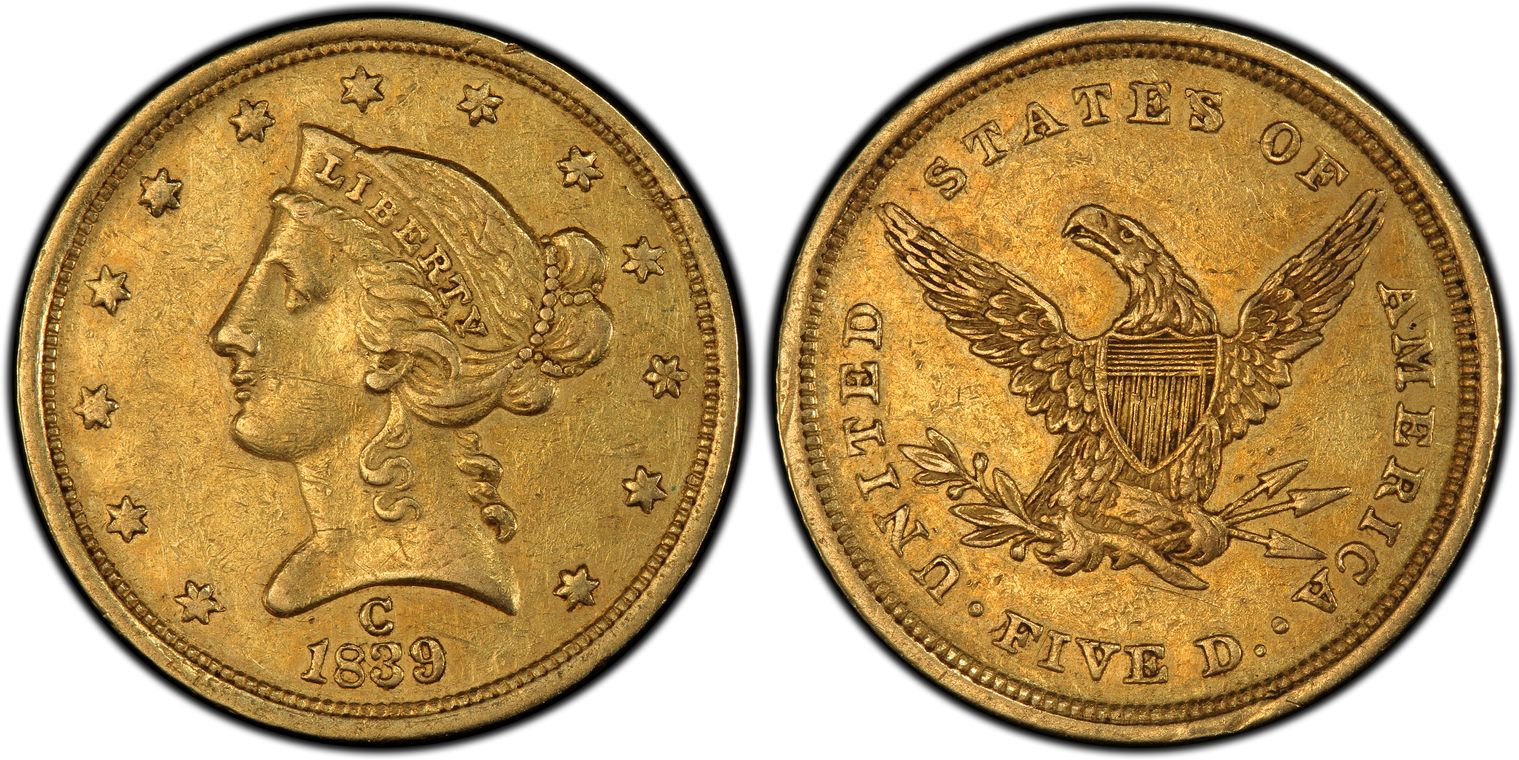1839-C $5 AU50 认证号26382987, PCGS号8192
拥有者评论
This first year type has exceptional smooth, nick-free, original surfaces, very uncharacteristic for the issue. Some luster still resides under the deep green-gold toning. A most attractive Charlotte specimen.
专家评论
Doug Winter
The 1839-C is another one-year type. Unlike the 1838-C half eagle, this issue is not well recognized by non-specialists. Christian Gobrecht’s design features a liberty head with the mintmark placed on the obverse. In 1840, the treatment of the head was changed substantially. The “Head of 1839” shows the back of back of the hairbun further from the tenth star and the neck more curved than on the “Head of 1840.” The Head of 1839 also shows the right end of the neck further from the final star than on the Head of 1840. Finally, on the Head of 1839, the series of curls at the rear of Liberty’s neck show an entirely shape and composition than those seen on the Head of 1840.The 1839-C half eagle is a scarce issue whose significance as a one-year type is finally appreciated. It is most often seen in Very Fine and Extremely Fine grades. It is very scarce in the lower About Uncirculated grade and rare in properly graded AU55 to AU58. Uncirculated examples are a bit more available than one might expect, possibly due to a small hoard having existed at one time.
The 1839-C has become more popular in recent years as collectors’ interest in one-year types and issues from the various branch mints has increased. For collectors who focus on Charlotte gold type, the 1839-C half eagle is an essential issue, and this has further increased recent demand.
STRIKE: The quality of strike seen on this issue varies. On the obverse the hair may be well detailed in some places and weak in others. Often times it is very weak on the bun as well as on the curls around the face. The stars are mostly flat with just a few showing definition on the radial lines. The reverse is better struck. The eagle is sharp with nearly full wing and feather detail. There may be touch of weakness on the eagle’s right leg and left talons but these areas are still defined and the lettering is bold. I have seen a small group of 1839-C half eagles that are uncommonly well struck, especially at the obverse border. These are desirable and typically command a premium when they are offered for sale.
SURFACES: The 1839-C half eagle is often seen with mint-made faults on the surfaces. These include areas of roughness and voids that are the result of improper planchet preparation. In addition, this is almost always seen with cluster of marks in the fields and on the devices. Any example with smooth, clean surfaces is very rare and it always commands a premium over the typical "choppy” 1839-C.
LUSTER: This issue has above-average luster. Original, higher grade pieces often show a blend of frosty and semi-grainy luster that can be very pleasing. On those that were made on poorly prepared planchets, the luster is not as good. The prooflike PCGS MS64 that I described in the second edition of my book as being a possible presentation piece or specimen strike no longer merits these possible designations in my opinion.
COLORATION: A distinct green-gold or medium orange-gold color can be found on undipped examples. The majority of the surviving 1839-C half eagles have been brightened and, as a result, no longer show original hues.
EYE APPEAL: There are a small number of extremely attractive higher grade 1839-C half eagles known. But the typical example has below average eye appeal due to weakness of strike at the central obverse, heavily marked surfaces and impaired luster.
DIE CHARACTERISTICS: The base of the E in LIBERTY shows doubling. This may be visible only on higher grade examples.
DIE VARIETIES: One die variety is known.
Variety 1 (formerly Variety 1-A): The date is low in the field with all four digits closer to the denticles than to the bust. The mintmark is positioned over the left side of the 3 in the date and it is nearly centered between the bust and the top of the 3. The reverse was used only in 1839 and it is the only issue of this type without the C mintmark.
At least two die states are known:
Die State I: Perfect dies. Most are from this state.
Die State II: There is a rim cud below the date. Scarce.
David Akers (1975/88)
The 1839-C is rare as a date and in AU or Unc it is extremely rare. It is slightly more rare than the 1839-D and the 1838-D and is very close in overall rarity to the 1838-C although it is easier to locate in EF or better than the 1838-C. Most specimens are rather softly struck on the hair curls around Liberty's face but the eagle is always sharp. The borders are also often weakly struck. This date is extremely popular not only for its rarity and the fact that it is a Charlotte Mint coin, but also with type collectors due to the obverse location of the mintmark.PCGS #
8192
设计师
Christian Gobrecht
边缘
Reeded
直径
22.50 毫米
重量
8.36 克
铸币数量
17205
金属成分
90% Gold, 10% Copper
更高评级数量
33
评级较低的钱币数量
87
地区
The United States of America
价格指南
PCGS 数量报告
拍卖 - PCGS 评级的
拍卖 - NGC 评级的
稀有性和存量估计 了解更多
| 所有评级 | 400 |
| 60或以上 | 10 |
| 65或以上 | 0 |
| 所有评级 | R-6.2 |
| 60或以上 | R-9.5 |
| 65或以上 | R-10.1 |
| 所有评级 | 86 / 112 TIE |
| 60或以上 | 59 / 112 TIE |
| 65或以上 | 1 / 112 |
| 所有评级 | 123 / 218 TIE |
| 60或以上 | 87 / 218 TIE |
| 65或以上 | 1 / 218 |





















